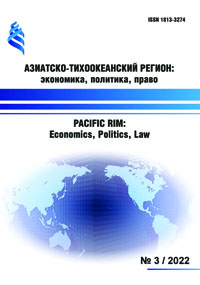ИНДИВИДУАЛЬНЫЕ ПРОГРАММЫ СОЦИАЛЬНО-ЭКОНОМИЧЕСКОГО РАЗВИТИЯ ПРОБЛЕМНЫХ РЕГИОНОВ РОССИЙСКОЙ ФЕДЕРАЦИИ
DOI:
https://doi.org/10.24866/1813-3274/2022-3/45-72Ключевые слова:
индивидуальные программы, социально-экономическое положение, проблемные регионы, механизмы, мероприятия, риски, стратегическое планирование, экономическое развитие, возможности, угрозы, предложения, результаты, пролонгация, финансированиеАннотация
В статье рассмотрены вопросы обоснования разработки и реализации индивидуальных программ социально-экономического развития для 10 субъектов Российской Федерации (далее – РФ). Отбор регионов для разработки индивидуальных программ социально-экономического развития (далее – ИПСЭР) производился Министерством экономического развития РФ (далее – Минэкономразвития России) в 2020 г. Регионы отбирались на основании исследования 4 показателей (среднедушевые денежные доходы населения; доля населения с денежными доходами ниже величины прожиточного минимума; уровень безработицы; инвестиции в основной капитал на душу населения) в трёхлетнем периоде социально-экономического развития среди 85 субъектов РФ. Среднедушевые денежные доходы населения изучались как показатели, характеризующие покупательную способность населения. Прогноз показателя среднедушевых денежных доходов населения выявляет потенциальные возможности населения анализируемой территории. Показатели доли населения с денежными доходами ниже величины прожиточного минимума, установленного в регионе, рассматривались как характеризующие уровень бедности, а его прогноз выявляет уменьшение (увеличение) денежных поступлений населения конкретной территории, доступных для сбережения. Показатели уровня безработицы, рассматривались как определяющие и характеризующие уровень и темпы экономического развития территории. Показатели инвестиций в основной капитал на душу населения изучались как характеризующие отобранные территории со стороны инвестиционной площадки для будущего развития предпринимательской деятельности. Анализ ИПСЭР проблемных регионов РФ проводился авторами в определённой степени с позиции как новация стратегического планирования, которая позволяет выявить в индивидуальных программах социально-экономического развития отобранных регионов их сильные и слабые стороны, а также возможности и угрозы. Результаты SWOT-анализа необходимы в будущем для корректировки комплексных планов индивидуального развития путём обоснованных мероприятий. Предложенные мероприятия будут направлены на снижение эффектов от будущих рисков, которые позволят изучить опыт исследования отрицательных и положительных сторон ИПСЭР проблемных регионов. Практическая значимость представленного инструмента стратегического планирования может проявляться в применении его результатов для пролонгации ИПСЭР проблемных регионов до 2027 г. с учётом уточненных целей стратегического развития.



